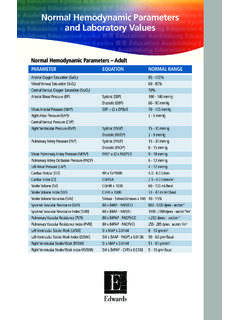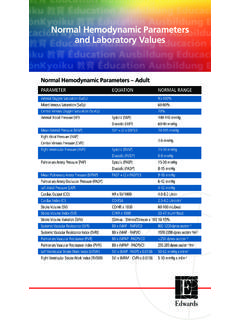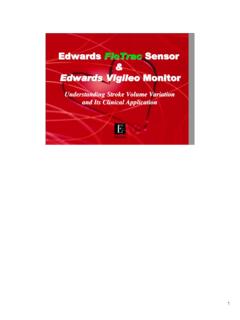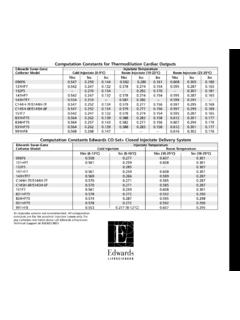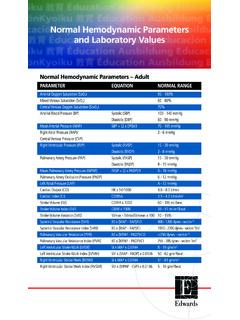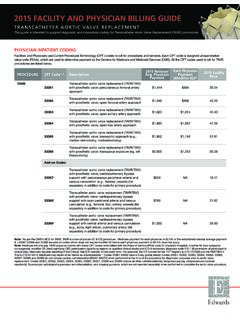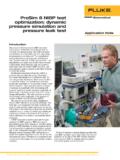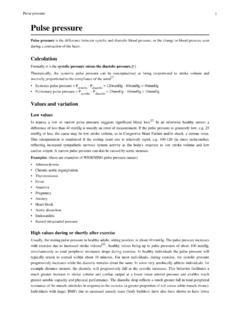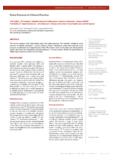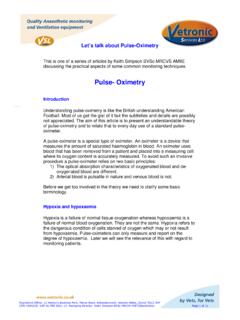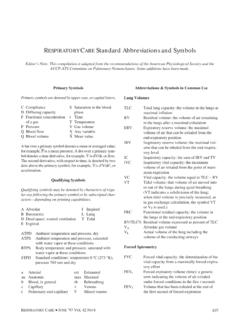Transcription of The Edwards FloTrac System FAQ
1 How does this technology work?The FloTrac System , consisting of the Edwards Vigileomonitor and the FloTrac sensor, uses a clinicallyvalidated algorithm to provide continuous cardiacoutput (CCO), stroke volume (SV) and stroke volumevariation (SVV) in real-time. The FloTrac algorithmutilizes arterial pressure, age, gender, and body surfacearea to calculate SV. The patient-specific SV is thenmultiplied by pulse rate to provide CCO. Patient-specific SV is updated as fast as every 20 can I rely on the data from thissystem with no manual calibration?One of the variables in the FloTrac algorithm accountsfor changes in compliance and resistance (vasculartone). The conversion factor Khi is a multivariatepolynomial equation which incorporates factors suchas the standard deviation of mean arterial pressure,skewness and kurtosis of the arterial waveform, andlarge vessel compliance as estimated by patientdemographics to assess peripheral vascular tone.
2 Khi srobust and dynamic nature makes manual calibrationunnecessary. Validation studies confirm the accuracy ofthe FloTrac System against both bedsidethermodilution cardiac output (CO) and continuousthermodilution ,2 These studies were performedagainst a range of patient demographics, pathologiesand CO does the FloTrac sensor compare tobolus cardiac output?The FloTrac algorithm correlates well with intermittentbolus cardiac output (ICO), showing a similar biasand precision as the Edwards Swan-Ganz CCOcatheters do to is required to obtain accuratereadings?The FloTrac System is dependent upon good intra-arterial pressure monitoring practices. Accuracy and fidelity of the arterial pressure tracing are important. Compromised waveforms due to dampened lines, kinked catheters, non-leveled transducers, etc.
3 May also compromise CO values. The FloTrac algorithm is sensitive to signal quality and frequency response. Thus, the FloTrac sensor must be used with the Vigileo monitor. Modificationof the sensor kit configuration ( , changing or adding tubing) is not advised and may compromise performance. Accuracy of input parameters (age gender, height, weight) is important to the FloTrac algorithm - incorrect values may affect CO Edwards FloTrac System FAQWhat are the limitations of the FloTrac sensor? The System has not been validated in artificial hearts and ventricular assist devices (VAD). Inaccurate CO measurements can be caused by intra-aortic balloon pumps (IABP). Severe, persistent arrhythmias may affect accuracy. Severe, persistent peripheral vasoconstriction or arterial spasm, such as in shock states, may dampen the arterial waveform resulting in erroneously low CO values.
4 Central arterial access ( , femoral access) is recommended in such conditions. The FloTrac sensor is currently not validated or labeled for use in pediatric is stroke volume variation (SVV)?Stroke volume variation is a naturally occurringphenomenon in which the arterial pulse pressure falls duringinspiration and rises during expiration due to changes inintra-thoracic pressure secondary to negative pressureventilation (spontaneously breathing). Variations over10mmHg have been referred to as pulsus paradoxus. Reverse pulsus paradoxus is the same phenomenon withcontrolled mechanical ventilation, however, in pressure rises during inspiration and falls duringexpiration due to changes in intra-thoracic pressuresecondary to positive pressure ventilation.
5 Normal SVVvalues are less than 10-15% on controlled mechanicalventilation. 3 SVV = (SVmax SVmin)/SVmeanWhat does SVV tell me? Why is SVV important?SVV is not an indicator of actual preload but of relativepreload responsiveness. SVV has been shown to have a veryhigh sensitivity and specificity when compared to traditionalindicators of volume status (HR, MAP, CVP, PAD, PAOP),and their ability to determine fluid is one of the first therapeutic interventionsclinicians turn to when optimizing DO2. The question oftendifficult to answer is: Can we use fluid to improvehemodynamics? and one might add, Is it the appropriateintervention? SVV as displayed on the Vigileo monitorwhen used with the FloTrac sensor may help answer such is normal SVV? Normal SVV values are less than 10-15% on controlledmechanical ventilation.
6 SVV below 10-15% indicates thatthe patient is not likely to increase CO through CO measurement be accurate when yousee a change in vessel compliance orresistance?Yes, the FloTrac sensor accounts for changes in complianceand resistance (vascular tone) and therefore does not requiremanual calibration to account for these changes. TheFloTrac algorithm incorporates determination of largervessel compliance via a Langewouters relationship, which isimpacted by age, gender and body surface Peripheralvascular resistance changes are assessed by a robustwaveform analysis in the I display data from the Vigileo monitor ona bedside monitor?Yes, analogue and digital communication ports are featured,similar to those of the Edwards Vigilance monitor and theEdwards Vigilance II monitor and can be interfaced withvarious bedside monitoring systems (Example: GE, NihonKohden, Philips Spacelabs).
7 The Vigileo monitor alsoprovides digital communications that can be directlyinterfaced with a data management System . Check withEdwards Lifesciences technical support or your bedsidemonitor provider for details. Can I use a Philips VueLink module with theVigileo monitor?Yes, software for the VueLink module is validated in theVigileo monitor. Not all parameters ( SVV) may bedisplayed on the bedside monitor using the VueLink I use my Vigilance monitor cables withmy Vigileo monitor? Edwards optical module cables are compatible with allEdwards oximetry technology monitors, including theVigileo monitor. The continuous cardiac output cable(70CC2) for the Vigilance monitors are specific for Edwards advanced technology Swan-Ganz catheters and are notcompatible with the Vigileo monitor or FloTrac sensor.
8 What about the link between the Vigileomonitor and central monitoring or datamanagement systems? Typical connection to central monitoring and datamanagement systems is through the patient monitor. TheVigileo monitor can be connected in the same manner as theVigilance monitor. The Vigileo monitor also provides digitalcommunications that can be directly interfaced with a datamanagement System . Check with your data managementsoftware provider for the FloTrac sensor be used on radial orfemoral arterial sites?Yes, it is accurate at both of these sites without calibrationas the algorithm automatically compensates for differentialcompliance and wave reflectance from one location is this different from the pulse contouranalysis or the pulse power technologies?
9 In short, both of these technologies require manualcalibration to initiate and/or maintain monitoring becausethey correlate CO with the area under the pressurewaveform while the FloTrac System does contour correlates the area under a portion of thearterial waveform with CO. This method requires calibrationto initiate monitoring and to detect the dicrotic notch power analysis requires calibration by theintroduction of an accurate CO value, typically a lithiumbased indicator, every 12 to 24 FloTrac algorithm does not calculate the area under thepressure waveform. Instead, CO is correlated with thevariance between systolic and diastolic pressure. Real-timeanalysis of waveform characteristics is also integrated,compensating for changes in vascular physiology affectingthe pressure :There are no absolute contraindications for using the FloTrac sensor in patients requiring invasive pressure.
10 Sepsis/Infection -Positive cultures can result from contamination of the pressure risks of septicemia and bacteremia have been associated withblood sampling, infusing fluids, and catheter related Emboli -Air can enter the patient through stopcocks that are inadvertently leftopen, from accidental disconnection of the pressure setup, or fromflushing residual air bubbles into the Catheter and Bleed-Back -If the flush System is not adequately pressurized relative to the patient sblood pressure, blood bleed-back and catheter clotting may -Excessive flow rates may result from pressures greater than 300 may result in a potentially harmful increase in blood pressure andfluid Pressure Readings -Pressure readings can change quickly and dramatically because of loss of proper calibration, loose connection, or air in the only.

